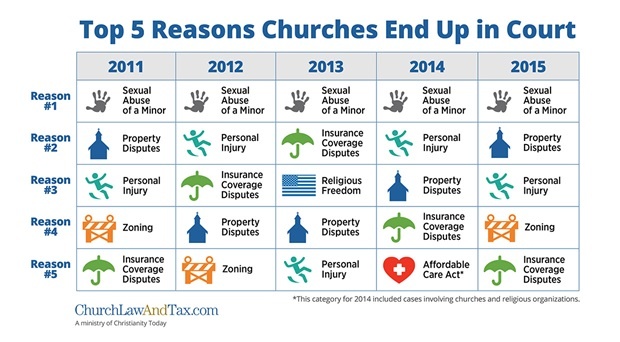
Richard Hammar – churchlawandtax.com
Has your church addressed these common legal liabilities and risk management concerns?
After reviewing thousands of published and unpublished rulings by state appellate and federal courts in 2015 that pertain to churches, I am able to identify the top five reasons churches go to court.
This list can be used by church leaders to know what common legal liabilities and risk management concerns should be addressed—or possibly even prevented altogether—by proper planning from pastors, church staff, church boards, and volunteers.
Here are the top five:
1. Sexual abuse of minors (11.7% of cases). Sadly, for several years the sexual molestation of minors has been the number one reason that churches went to court. Victims in these cases generally allege that a church is responsible for their injuries on the basis of negligent selection, retention, or supervision of the perpetrator. Churches have lost many of these cases due to their failure to implement appropriate safeguards in the selection and supervision of employees and volunteers who work with minors.
Incidents of sexual misconduct involving minor victims can be devastating to the victim, the victim’s family, the offender, church leadership, and the church itself.
Because this issue remains the number one reason churches go to court, and because of the significant harm that can be done to children, their families, and church leaders, churches need to take an aggressive position on this matter. Churches must implement policies and procedures that demonstrate proper screening and training of staff and volunteers, proper processes for reporting actual and suspected cases of abuse, and specific attention to to proper supervision and other measures that ensure accountability.
2. Property disputes (10.2% of cases). Churches frequently are in court to litigate property-related issues. Common examples include eminent domain, restrictive covenants, reverter clauses, religious discrimination in the rental or sale of property, and adverse possession.
3. Nonsexual personal injuries (9.5% of cases). These injuries can occur in a variety of ways, including slips and falls, vehicle accidents, playground equipment, and assaults on church property. Church liability for injuries occurring during any of these activities generally is based on negligent selection of workers, or negligent supervision of the activities and participants. Churches can reduce the risk of injury, and of negligence-based liability, in a number of ways, including the use of qualified adults and “benchmarking” safety procedures and risk management with the practices of other charitable organizations and public school districts.
4. Zoning (4.9% of cases). Many of these cases involve claims under the federal Religious Land Use and Institutionalized Persons Act (“RLUIPA” or “the Act”). RLUIPA was enacted by unanimous consent of both the Senate and House of Representatives in 2000. It addresses two areas where religious freedom had been threatened: (1) land-use regulation, and (2) persons in prisons, mental hospitals, nursing homes, and similar institutions.
RLUIPA specifies that state and local governments cannot subject religious organizations to a “land use regulation” that imposes a substantial burden on the free exercise of religion unless the law is supported by a compelling governmental interest. The courts have reached conflicting conclusions regarding the application of RLUIPA, and the meaning of a “substantial burden on religious exercise.”
5. Insurance coverage disputes (4.5% of cases). It’s common for churches and their insurers to end up in court, often in a declaratory judgment action, in which a court is asked to determine if coverage is available under a church’s policy for a particular claim. Common kinds of coverage disputes include the intentional misconduct exclusion, the employment practices exclusion, the duty of prompt notification, and misrepresentations on the application for insurance.
Church leaders should review their policies with their insurance agents to understand what is covered, what isn’t covered, and what special types of coverage must be obtained. Senior church leadership should handle insurance applications, or at least review them, to make sure careless mistakes aren’t made that might be later viewed as “misrepresentations on the application for insurance.”






















